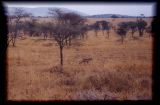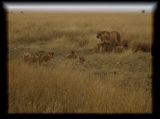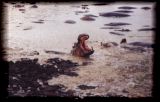Her head was large, her stance majestic, her gaze cool. She sat a few yards away from my window. Her pupils were a tawny brown, set among yellowish cornea. Around and on her played a couple of lion pups, whom she seemed indifferent to. My gaze was locked into hers. I felt hypnotized. And she? It was hard to tell. Her expression remained neutral throughout the “encounter.”
We were in a typical, safari vehicle — a four-wheel-drive jeep, whose roof could be raised completely. Right then it was down. There were about a dozen similar vehicles around. We were parked at the edge of a broad dirt track in the world-famous Ngorongoro Conservation Area, in the Northern Highlands of Tanzania.
“Keep your window rolled up. And don’t stick your head out,” said our guide and driver, Good Luck, helpfully.
Thanks buddy, I thought. My window was open a couple of inches, for air. And even a million dollar offer would not have compelled me to roll it down and stick my head out! All sorts of animal factoids had been in circulation during our safari. One, swapped the next day, was this: avoid eye contact with wild animals, especially prolonged eye contact. It can be perceived as a threat. “Thanks buddy,” I had thought then, recalling my long eye-lock with the lioness, the day before.
We were in a safari traffic jam! This happens every time “the big five” are spotted – lion, elephant, leopard, rhino, buffalo. Or even when it’s giraffes, huge herds of zebras and wildebeest, a cheetah in a distance or a troop of baboons. Or huge flocks of flamingoes, pelicans or other birds resting at the edge of a lake. Or a pond full of hippos. The Northern Safari circuit provides innumerable opportunities for gawking and being overwhelmed with awe at the beauty, diversity, grandeur and mystery of creation.
The scene before our eyes was absolutely spectacular – completely worthy of a traffic jam!
Some distance away, to our right, in low, rust-coloured grass, was the focal point of the tableau – a lion (simba in Kiswahili), half hidden, nibbling at the hind quarters of a wildebeest. To his left, a little distance away, sat three lionesses, in a triangular formation. To his right were three jackals, also in a triangular formation, and beyond them three hyenas. Three more lionesses were ranged close to the road and this is where “my” lioness sat. Two more lionesses and a lion were actually right on the road, scattered among the cars! On the other side of the road sat a lone lioness.
The mathematically oriented among you will already know that the scene consisted of no less than 2 lions, nine lionesses, 2 lion cubs, 3 jackals and 3 hyenas – wa, wa, woom! All of them were seemingly hanging out to receive chunks of meat from a lone wildebeest, if his majesty, the lion in charge, allowed.
This safari was my first encounter with lions. I had seen tigers before, in India, from the back of an elephant. Somehow, that had been more reassuring, even though a tiger gives the impression of more compressed killer-instinct than a lion, who can look surprisingly benign – like a big, lazy, slightly dopey cat. (Lions sleep 20 out of 24 hours.)
The males in fact are really lazy! They seem like the ultimate chauvinists — the lionesses do all the hunting, and look after and train the pups. (Looking after and training the young is the exclusive role of the females of all species, save humans.) The lions just claim the spoils, contribute sperm and roam around as rugged individualists! It seems that they meet their just desserts as they age: old, alone, weak – the “King of the Savannah” — can be eaten alive by packs of African wild dogs or hyena. (O.K., it you want a less opinionated travelogue you will have to go elsewhere!)
Lionesses typically hunt once a week. Lions can eat 50 kgs of meat at a time! A lion can weigh as much as 300 kg; a lioness 200. At times hunting in groups, they use different strategies. For example, some lionesses surround a herd and hide in the grass. Then another lioness scares the animals towards the hiding lionesses who jump the victims.
We didn’t see any lions for a while, just lionesses, sprawled on top of a rock outcrop, in the distance, at Tarangire National Park, walking along a lake in Seronera – the central part of the 14,763 square kilometre Serengeti National Park, resting with a number of cubs, by the road, as we headed out of the Serengeti and into Ngorongoro. The cubs were tho thweet — running around, jumping on each other and on the adults, sparring and breastfeeding.
The Ngorongoro Caldera
The Ngorongoro Conservation Area is set among cool, beautifully verdant, volcanic highlands between the Great Rift Valley (described in the Hadzabe article) and the endless, grassy plains of the Serengeti.
At the heart of this area is the Ngorongoro Crater (or the more poetic name for it, caldera), a fascinating geological formation and a breathtakingly beautiful site. It was formed some 2.5 million years ago through volcanic activity which caused a “collapsed mountain” to create the world’s largest unbroken and unflooded caldera – 19 km in diametre and 600-metre deep. The word Ngorongoro prosaically means deep hole! This deep hole has a population of 25-30,000 large mammals.
In a single day in the crater we saw the following: about 15 slumbering hyena, with one sitting on guard, a black backed jackal, two black rhinos (a highly endangered species), wild buffaloes, hordes of wildebeest and zebras, Thompson gazelles and some Grants Gazelles, two Hartebeest, many Baboons, some Squirrels and Hippos, and two male elephants in a distance. (The caldera does not have the kind of vegetation needed to support elephants and giraffes, but wait, we saw loads of these elsewhere!)
Inside the caldera are stretches of grassland, barer sandy stretches which cause enigmatic dust devils at a distance, an acacia or fever tree forest, and an alkaline lake whose dimensions shrink or swell with the season. On the shore of the lake we saw scores of Pelicans and a smattering of other birds – Flamingoes, Herons, Sacred Ibis and Egyptian Geese.
Wildebeest literally run wild here! To see the wildebeest in this state is to connect with prehistoric humans. Cave paintings of humans with ‘puny’ spears hunting these beasts spring to mind. (Wildebeest or gnus are not aggressive.) The photo we took of a single wildebeest framed against the foggy vapours emanating from the alkaline lake conveys a feeling of timeliness.
Many species of antelopes and gazelles live in the East African grasslands. Among them are the rather peculiar looking Hartebeest (kongoni), with their very narrow faces and humps. They may be less than elegant, but they are among the fastest and most enduring runners among antelopes. Unlike the wildebeest, who move constantly in search of good grazing grounds, live in massive herds and breed fast, the hartebeest is the most sedentary of antelopes. They live in small groups, making them easier prey for the big cats as well as hyenas, jackals, hunting dogs and humans. The wildebeest seem to have a clear evolutionary advantage; while their numbers have enlarged, those of the hartebeest have diminished.
The crafty hyena
We first encounter a spotted hyena, one of the predators of the grass eaters described above, and survivors par excellence, as we headed for our camp in Seronera. “It” appeared suddenly by the side of the road. The jeep stopped and we started shooting as the hyena posed gamely for our cameras. I used to think of the hyena as ugly but familiarity breeds acceptance. That, the new-found respect for their survival skills, and my brother’s enthusiasm about them has me thinking of their looks now as “interesting”!
A skilful hunter and scavenger, hyenas can eat anything, from animals of various types and sizes to carrion, bones, vegetable matter, other animals’ droppings. They choose their prey well – young animals or animals in vulnerable situations, and efficiently zoom in on the kill, alone or in small groups. They hunt at night.
Their powerful jaws and strong digestive tracts, which can handle rotting meat (like vultures), have even allowed them to eat metal, it is reported! Humans are the only predators (and they can kill humans too) of this very “successful” species that is highly intelligent and very social. They communicate with each other through specific calls, postures and signals. The groups have a pecking order of dominant and less dominant males or females. They live in burrows, and we saw some of these in Ngorongoro.
They are supposed to have cannibalistic tendencies. That is one of the reasons why the females look like the males, it is speculated, so that they appear large and strong to protect their young from the males. Hyenas are one of the animals that have been stereotyped as timid and depending mainly on other animals’ kills, which turns out to be somewhat false.
The big `uns!
The most impressive animals in the wild were the giants – rhinos, hippos, elephants, wild buffaloes: size matters! Thank god they are all herbivores and not our natural predators! After the African elephants (bulls can weight 5000 kilos) and male hippos (1500-3200 kg) male rhinos weigh around 1200 kg.
We saw one black rhino at a time, grazing at a distance. Rhinos are loners, and can be extremely aggressive. Even mating involves snorting and sparring. However, like a yogi in a remote mountain cave, their main diet is leaves, fruits, flowers and herbs!
We also saw another aggressive animal, the wild buffalo (male, 680 kg) in Ngorongoro. Said to demand respect even from a pride of lions, adult buffaloes have few natural predators. Multiple lions can kill one, but a group of buffaloes have killed a lion on occasion. Newborn buffaloes can be killed by leopards or spotted hyena. Buffaloes are known to gore, trample and kill several people a year. They do not look very different from the benign, domesticated Asian buffaloes, except for being somewhat bigger, but they most certainly are different!
Hence we were surprised to see two, grazing placidly at the edge of our misty campsite on the crater rim, when we returned there after our day safari. They were “reported” and later wardens arrived and drove them off (while we were asleep) luckily in the opposite direction from the many flimsy looking tents!
Overall, human physical strength and prowess (e.g. speed) is negligible in the face of all these creatures, and our admiration for our ancestors’ ability to survive and thrive grew exponentially. We concluded that possibly the only creatures we could have defended ourselves against bare handed were the shy and small dik diks! We’d be no match even for the gazelles with their sharp horns, certainly not the zebras or the antelopes with their powerful kicks or the intelligent and strong baboons.
The maasai
The Ngorongoro Conservation Area (8288 sq. km.), which includes the caldera, “allows” some 40,000 masaai and other pastoralists to live and graze their cattle here, though the rich-in-wildlife crater itself is forbidden to them. The bordering Serengeti National Park, all 14,763 sq. kilometers of it, also the traditional homeland of the pastoralists, is now totally forbidden to them. The tall, dignified masaai, once proud and warlike, cut a striking figure in their draped, red, purple, blue and green blankets, gorgeous and plentiful woven, bead jewellery, staffs in hand, be it in a rural or urban setting. They are being forced to “settle” and accused of degrading the limited pastoral land they are allowed to use.
The most successful conservation efforts worldwide are those that accommodate the needs of nature along with those of the traditional human users of the land. How can it be otherwise? The Tanzanian conservation efforts are top-down. In fact, pastoral land here is degrading precisely because the maasai are limited to so little, leading to over grazing.
Some maasai have been driven to destitution, their traditional wealth – cattle herds – shrunk to a symbolic value. You see many of them hawking their bead jewellery in the typical Tanzanian tourist destinations. There is this idea that they shun education. A documentary film made by HakiElimu shows this not to be the case. It seems to me that they are quite right to shun an imposed model of education. Many ethnic groups have done so.
As our guidebook put it, the maasai, trying to hold on to their ethnic identity and lifestyle (which includes customs like drinking milk mixed with cattle-blood and the ideal of warriorhood for men), remain marginalized from the Tanzanian mainstream. This is certainly my impression. The other ethnic groups in Tanzania seem to regard them as “backward,” though nothing is said openly. (Not that much is said openly in Tanzanian society, and certainly not to wazungus — foreigners.) Between the national parks, we often saw maasai boys herding. Our driver would stop sometimes to give them water bottles.
It was said that their fathers were out drinking. Is this a sign of community breakdown or was it always so? We did not find out. Of course there are educated, city-dwelling, “modern” maasai (the CUSO program officer for e.g. is one.)
I had another impression of maasai life altogether from reading a fascinating novel by a Kenyan masaai writer, Henry R. Ole Kulet, entitled, “Is it possible?” The book, written in the early 70s, shows the maasai being forced to send one son per family to a government, boarding school. Lerionka, the young maasai protagonist, who is sent to school, desires both education and a maasai life. The book chronicles, in a very real way, maasai customs and individual and community dilemmas as they confront the forces of modernity.
We were perhaps lucky not to go to a typical maasai, orchestrated-for-tourists village in the Ngorongoro area. The guide book recommends this, but a Spanish couple who went found the experience very commercialized. We did stop at a small, contemporary maasai village, near Moshi, and enjoyed our visit. It was not a particularly romantic or dramatic encounter and that is precisely the point. The maasai are human. They should not be showcased as museum exhibits.
The men here earned a living from mining. The community grew corn and lived a mostly settled life. There was a church nearby. They kept many of their customs. We were genuinely invited to a wedding, in a few months time, of Noel, the young maasai man who led the cultural tourism program there.
Other communities were driven off these parklands, like the hunter-gatherer Hadzabe. I do believe there should be national parks. These parks provide an income for a poor country like Tanzania and, in fact, form part of their “wealth”. Also, this is an effective way to protect the animals, some of the species being highly endangered outside the park borders. The question is: Who is benefiting from all this park “development”?
There is an effort to develop cultural tourism programs, in consultation with local communities, in many parts of Tanzania. Part of the fees you pay here go to the community, part to the local organizers and guides. We have participated in some of these. For example, a program is on offer at Mto Wa Mbu (River of Mosquitoes, slap, just got another one!), on the shores of Lake Manyaya. Our guide was a knowledgeable, pleasant, English-speaking young man, who was putting himself through college. He led us through this village, explaining cultivation patterns, particularly how the ubiquitous ndizi (banana) was grown. Of course we ended up drinking banana wine and barley beer in a local watering hole! Not all the cultural programs are as good, in the sense that they may not be as in-depth and well-planned as one would wish for, but it is important to try them out.
They are a good beginning in terms of sustainable and equitable tourism, but a lot more needs to be done. And the central question of access to and ownership of traditional lands needs to be tackled head-on. There is huge displacement of both settled and nomadic populations, in the name of tourism and development, worldwide. In some ways, Tanzania is only beginning on that brutal path.
Nascent attempts at organizing and fighting for their rights are emerging, at least among certain groups, including the masaai. Let’s pray that they succeed (and write letters, make donations, sign petitions at least)! We chose to go with a socially and environmentally conscious travel agency called Tanzanian Journeys. We were very well rewarded for this in every way, including the continuing friendship of the two owners. We did not pay more either. (We would be very happy to give you their email, or to your friends, travelling to the region.)




















